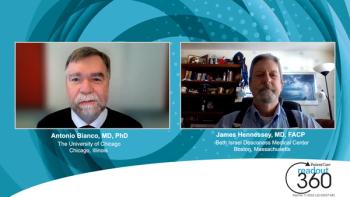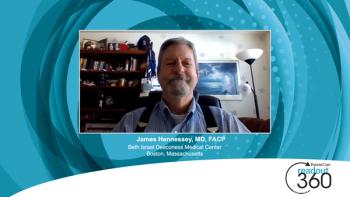
The Extremes of Thyroid Disease: Myxedema Coma and Thyroid Storm
Myxedema coma and thyroid storm can both masquerade as disease in multiple organ systems. Both also can be fatal.
Some thyroid disturbances are life-threatening, and as a result, are associated with substantial morbidity and even death. Myxedema coma-one end of the “serious” thyroid spectrum--may be defined as the culmination of severe, untreated hypothyroidism. Unfortunately, it is a difficult diagnosis to make. Persons with the condition are not always in a coma!1 There are no unequivocal diagnostic criteria available.1 Neither the magnitude of TSH elevation or the decrease in T4 values correlates with the severity of the disease.1 However, failure to make the diagnosis can be fatal.1 Thyroid storm-the opposite end of the thyroid disease spectrum-has a clinical scoring system to assist with diagnosis. Like myxedema coma, it also can masquerade as disease in multiple organ systems. Unfortunately, it too can be fatal. A top-line primer on each follows.
Myxedema coma
⺠Although there are no unequivocal criteria for a diagnosis of myxedema coma, clinical researchers have identified certain findings suggestive of the diagnosis. There are six2:
1. Altered mental status that may include coma
2. Hypothermia (cold exposure itself can lead to myxedema coma)
3. Bradycardia
4. Increased TSH level
5. Decreased T4 level
6. An illness that precipitated myxedema coma (such as a urinary tract or other infection). In fact the diagnosis of myxedema coma should lead to an exhaustive search for a trigger.
⺠Remember certain newer pharmaceuticals-such as iodine-rich amiodarone-can cause severe hypothyroidism and myxedema coma.3
⺠Other laboratory abnormalities such as hyponatremia may be present. Creatinine phosphokinase also may be elevated.
⺠Once a diagnosis of myxedema coma is made, how is it treated? An ICU transfer is a good place to start.1
⺠There may be a place for T3 in treatment, but that choice is still controversial; most people use levothyroxine (T4).1
⺠Respiratory depression should lead to intubation and ventilatory support.1
⺠External warming is to be avoided-it may cause vasodilatation and circulatory collapse.1
⺠Glucocorticoids are administered at least until adrenal insufficiency is eliminated as a possibility.1
Thyroid storm
⺠Multisystem involvement is common with cardiovascular, neuropsychiatric, gastrointestinal-hepatic, and thermoregulatory disturbances.4
⺠The scoring system used for diagnosis of thyroid storm is the
. Gastrointestinal-hepatic dysfunction is graded as absent, mild (diarrhea, nausea-vomiting, abdominal pain= 10 points), or severe (jaundice= 20 points)
. Heart failure is graded as absent, mild (pedal edema), moderate (bibasilar rales), or severe (pulmonary edema= 15 points)
. And, central nervous system dysfunction is graded as absent, mild (agitation= 10 points), moderate (delirium, psychosis, extreme lethargy= 20 points), or severe (seizures, coma= 30 points).
. A total score of ≥45 is highly likely for a diagnosis of thyroid storm; 22 to 44 is suggestive of the diagnosis, and <25, makes the diagnosis unlikely.
⺠Treatment of thyroid storm includes:5
. Propylthiouracil (250 mg every 4 hours)or methimazole (20 mg every 6 hours)
. Potassium iodide 5 drops every 4 hours,
. Cholestyramine (to bind thyroid hormones in the gut) 4g every 6 hours,
. Beta blockers especially for increased heart rate and the slowing of atrial fibrillation,
. Glucocorticoids (hydrocortisone 100 mg every 8 hours after an loading dose intravenously of 300 mg),
. Acetaminophen or a cooling blanket,
. And, treating a precipitating illness after and if it is diagnosed. As with myxedema coma a triggering disease should always be sought.
⺠Remember amiodarone can also cause hyperthyroidism, not just hypothyroidism.
⺠Elderly patients may have “apathetic” presentations, that is, listlessness, delirium, and atrial fibrillation without other features of hyperthyroidism and also may experience thyroid storm.6
Newsletter
Enhance your clinical practice with the Patient Care newsletter, offering the latest evidence-based guidelines, diagnostic insights, and treatment strategies for primary care physicians.




















































































































































































































































































































